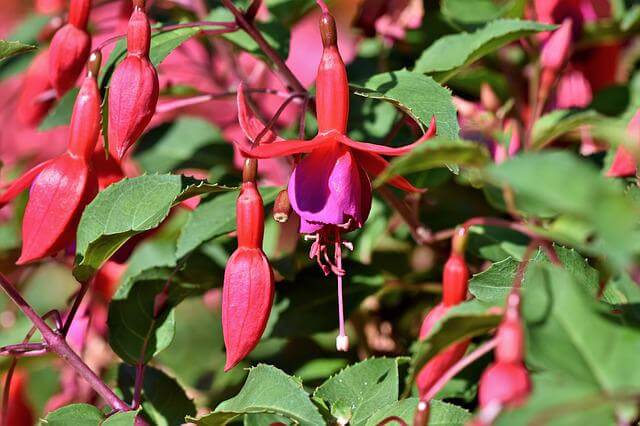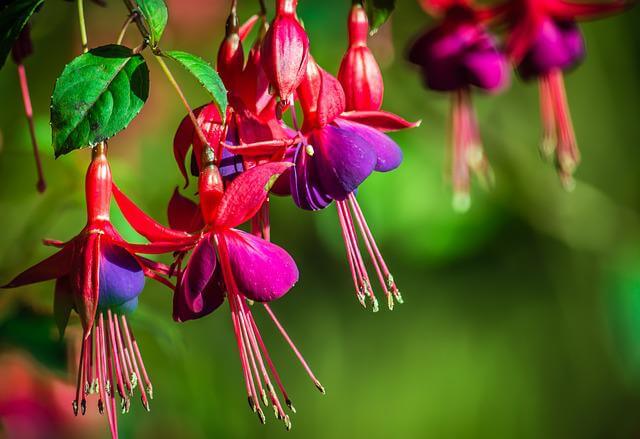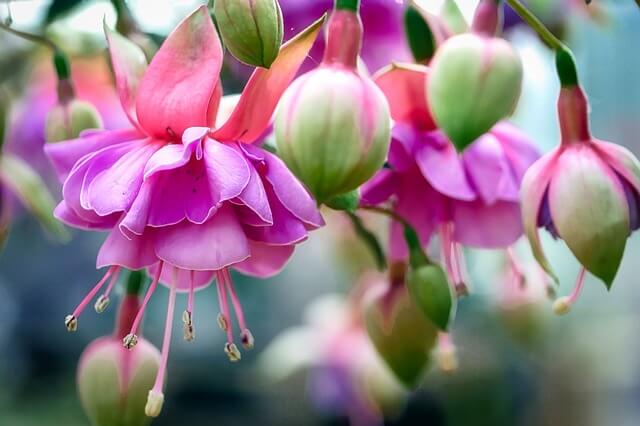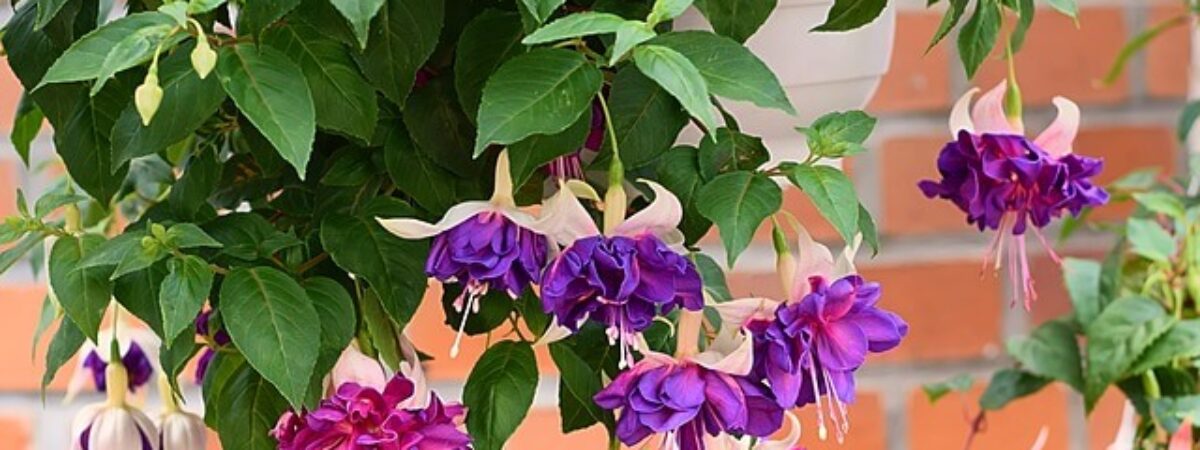Fuchsia is a beautiful flowering plant famous for its hanging, bell-shaped, colorful, bi-colored flowers that look like a dancing skirt. These beautiful and colorful flowers are available in multicolor blossoms and thousands of shades of white, candy pink, magenta, purple and red. Some varieties also have golden or variegated foliage, or purple or red-tinged leaves.
Being native to the south and central America, these are pollinated by the hummingbirds and was first discovered by the French botanist Charles Plumier. Later on, it was named by the German botanist Leonard Fuchs. This plant can be bushy, trailing, or vining.
The outer part of the flowers are generally not petals, actually, they are sepals that protect the petals of the flower beneath. These are generally purple in color but breeding can create a huge range of color combinations.
The flowers and the seeds of the fuchsia are eatable. Besides, the flowers also can be utilized for decorating the cakes by crystallizing them. Its fruits of it have a sour and peppery taste and are used heavily to make jam.
Some popular varieties of fuchsia
Fuchsia army nurse
This variety of fuchsia is a hardy shrub that bears purple, semi-double flowers with red sepals, throughout the whole summer. This variety can be grown in a mixed herbaceous border as well as in containers.
Fuchsia is a beautiful flowering plant famous for its hanging, bell-shaped, colorful, bi-colored flowers that look like a dancing skirt. Click To TweetFuchsia dollar princess
Fuchsia dollar princess is a popular variety of the plant that usually bears small, double flowers with short, purple tubes and red sepals, along with dark-green leaves this variety is recommended to grow in pots on the patio in partial shade.
Fuchsia Alice Hoffman
Fuchsia Alice Hoffman is a small, shrub fuchsia that has bronze-tinged foliage and semi-double flowers with pink sepals and white-pink petals. It is recommended to grow this variety in a mixed herbaceous border in partial shade, or in a pot in a sheltered, part-shaded place.
Fuchsia ‘Blands New Stripe’
Fuchsia ‘Blands New Stripe’ is a popular shrub of it with a weeping habit. This variety usually bears unusual flowers with striped violet and pink petals and red sepals, along with dark green foliage.
Fuchsia ‘Champagne Celebration’
Being a beautiful shrub of it, this variety bears gorgeous flowers with flared, carmine-pink petals and pink-white sepals in contrast with very pointed tips.

How to grow fuchsia plant
The fuchsia is very versatile in nature. Thus they can be grown as standalone shrubs, climbers, informal hedges, or standards, along with as bedding plants in pots and hanging baskets for beautiful displays.
- If you are planting the hardy varieties, you should plant them in spring or early summer. The procedure to grow the fuchsia plant is given below
- Prepare the soil required for the growth of the plant. Add some well-rotted organic matter to it. Water it abundantly.
- When the danger of frost has passed, generally they may plant this plant into the prepared soil. Harden them off for a week or two weeks beforehand.
- Add a thick layer of mulch like well-rotted manure and garden compost to lock the moisture. Water it regularly until it is established.
- Add some fertilizer and let the plant grow.
How to take care of the fuchsia plant?
Fuchsia plants are generally easy to grow plant however it is slightly fussy about temperature and moisture. So with the proper caring guide, this plant can shower you with gorgeous and edible flowers and seeds.
The proper caring guide for this plant includes
Light
These plants require bright indirect sunlight to grow. It also can thrive well in part shade to deep shade conditions. If you are growing this plant indoors, it enjoys a bit more light bright indirect light rather than direct sunlight.
Temperature
Most the fuchsias grow well in temperatures between 55 to 80 degrees Fahrenheit. Besides, there are certain heat-tolerant cultivars of these plants exists that require 90 degrees Fahrenheit of temperature to bloom. There are certain varieties of this plant that is hardy in freezing temperature.

Water
Fuchsias like moist soil but not soggy. So water the plant as required. They thrive well in humidity, so if you are living in a somewhere dry place, it can be a little more challenging to grow. So keep the plant hydrated as much as possible.
Soil
Fuchsia plants thrive well in the soil with a good ratio of organic matter. So it prefers consistently moist soil but it should not be soggy.
At the same time, the soil in which you’re fuchsia grows should be well-draining. So if you are growing it indoors, try to amend it with peat moss or compost before planting which will provide organic matter to the soil and keep it well-draining. Plants that grow in a container do fine in an ordinary peat-based potting mix but make sure the pot has good drainage.
Fuchsia plants are generally easy to grow plant however it is slightly fussy about temperature and moisture. Click To TweetHumidity
Fuchsias are heat-tolerant plants. So if you are living in a dry region, it is required to mist the plant regularly to provide them sufficiently moist.
If you are growing the plant indoors, it can be quite tough to take care of it during the winter the space is more likely to be over dry. You can run a humidifier to control the humidity level.
Fertilizer
Fuchsias have a huge appetite, during the growing season. So you may need to feed the, regularly with diluted fertilizer. The combination of fish emulsion and seaweed can be a great feed for them.
How to propagate the fuchsia plant?
Fuchsia plants are easy to take care of. This plant can be propagated through stem cutting. Propagation should be done during the spring season.
Propagation can be done by the following procedure.
- Cut off the stem of a mother plant. The segment should be two to four inches long. It is required to cut the stem above the third pair of the leaves.
- Remove all the leaves, and flowers from the cutting part.
- Dip the cutting in a rooting hormone to facilitate growth.
- Plant the cutting into a pot, container, or ground with a seed starter mix or into a blend of sand, peat moss, and perlite.
- Cover the plant with a loose, clean, and clear plastic bag to bind the moisture within the plant.
- Place the plant in a warm location.
- Roots will start growing in three to four weeks. Now you can uncover the plant.
- When the plant will start growing new leaves, you can re-pot it into a large container or take it outdoor.

Common pests and diseases
Fuchsia is prone to different pests like spider mite, aphids, and whiteflies. If you ever notice that your plant is more likely to be attacked by this plant, you can use insecticidal soap to control them.
vine weevil is a common pest of this plant that are more likely to attack this plant, especially if you’re growing them in pots. These weevils generally notch out of the leaves.
Besides the white grubs is another common pest on fuchsia that do the real damage. Generally, they feast on the roots of the plant underground and can kill them before the problem is spotted. If your plant is suffering from this disease, it is recommended to apply a biological nematode control. You can also apply chemical solutions to control them.
Conclusion
Fuchsia is a beautiful, eye-catching, vibrant plant that blooms all during the summer along with its glorious teardrop-shaped flowers in the shades of vivid colors.
Sometimes, it was heard that it is a fussy and temperamental plant that requires a lot of maintenance. but that’s not true. If it was given the conditions it prefers, it will grow happily and will show off its luscious color for months at a time.
Now that you have read the whole article and now you’re prepped and ready to go, you can bring this beautiful fower to your home.
You may also like to read
How to grow and care for moss rose- A complete guide
How to grow and care for poinsettia plant-A step by step guide






